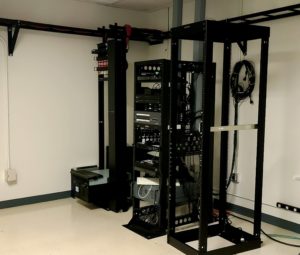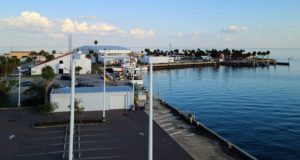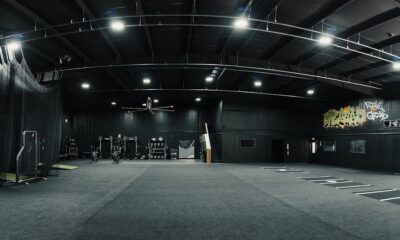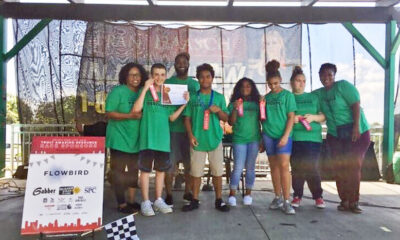Thrive
College of Marine Science, Innovation District unveil new facilities

The area around Bayboro Harbor and the Port of St. Petersburg is home to several advancements in marine science, and two new facilities will soon advance those ideas – all of which are made possible by strong partnerships.
In this spirit of collaboration, the St. Petersburg Downtown Partnership led board members and friends on a walking tour of the proposed site for the USF Interdisciplinary Center of Excellence in Environmental and Oceanographic Science (EOS) and the new Maritime and Defense Technology Hub. Dr. Tom Frazer, Dean of the USF College of Marine Science (CMS), and Alison Barlow, Executive Director of the Innovation District, guided the tours of the respective facilities on Monday.
Frazer began the tour in the Knights Oceanographic Research Center. This new, modern building with its clean exterior and blue-tinted glass panels overlooking the harbor stands in stark contrast to the adjacent Marine Science Labs (MSL). The MSL building is 80 years old and was part of the original U.S. Navy Maritime Training Center. Built to assist the war effort during World War II, the building shows its age but will soon make way for the state-of-the-art EOS.

Built during World War II for the Navy, the Marine Science Laboratory building will be the new site of the EOS.
“We came to talk a little bit about a building,” said Frazer. “But the building is part of a larger vision of what we have for the St. Petersburg campus and the community.”
Frazer said the school is aggressively pursuing the EOS and brought the group to the research center to provide a bird’s-eye view of its future location. He explained the facility will provide 40,000 new square feet and repurpose certain sections of the existing MSL building. The EOS will not only house USF’s many marine research and teaching endeavors, but the soon-to-open Florida Flood Hub for Applied Research and Innovation will also call the EOS home.
“I don’t think there’s a better place in the southeastern United States, and arguably the nation, to carry out that work,” said Frazer. “We’re right on the coast, and we see the effects every day.”
Frazer said the EOS is the number one priority for USF moving forward, and that it enjoys legislative support from local government through the speaker of the Florida House. Frazer also noted the backing of community partners such as the Innovation District, Downtown Partnership and the Chamber of Commerce.
“We feel good that we’re going to get there,” he stated.
Frazer said the EOS will employ a data visualization program to work closely with the Flood Hub and other marine research projects. The College of Arts is involved with a communications and digital journalism program to assist in communicating data. Frazer noted the importance of taking complex imagery and communicating it with the public, beyond planners and elected officials.
Frazer said there are also discussions with the College of Business to create a “blue MBA” to guide students through the business aspects of a marine-based economy.
“When I think about this – there are so many synergies,” he added.
Frazer concluded the tour of the future EOS by highlighting the college’s remote-operated underwater gliders. The CMS currently operates five of these submersibles, and several more are out for repairs. Chad Lembke, project engineer for the CMS, said the vessels are at sea for weeks or even months while collecting data and can carry different sensors depending on the focus of the research.

These remotely operated underwater gliders are at sea for weeks or even months while collecting data. The programs will expand with the creation of the EOS.
Lembke said the program’s recent focus is on the origins of red tide, with the goal of better predicting when a harmful algal bloom will occur and how long it will last. The vessel also measures the temperature of different layers of water – something that can only be accomplished with a submersible. This information guides hurricane forecasts, and the CMS plans to bolster these projects when the EOS is complete.
Following a short walk along the waterfront, Barlow led a tour of the new Marine Defense and Technology Hub. After months of planning and negotiations, the Innovation District formally took control of the former SRI International building in October.
The Innovation District will move its operations to the building when it opens the first week of January. Barlow said it will host monthly tech exchange events for both the Hub’s tenants and the surrounding community. Barlow also relayed a proposal with St. Petersburg College for an “innovative, cohort-based intern project.”
A key feature of the building is its Sensitive Compartmented Information Facility (SCIF) rooms. SCIFs are necessities for industries that require secure communications, making the building uniquely suited for military, national security and defense operations.

A look inside one of the Sensitive Compartmented Information Facility (SCIF) rooms. SCIFs are necessities for industries that require secure communications.
“We’ve got four of those,” said Rob Kapusta, board president of the Innovation District and member of the Downtown Partnership’s executive committee. “Which made this a star attraction for a number of defense technology companies.”
Barlow explained the building was a single-tenant building. She said she had to convince city officials it would not only work for multiple tenants, but collaboration would thrive with the close proximity of several companies.
“They have to have a common kitchen, common bathrooms and common conference rooms, so they’re going to have to interact a lot with each other,” said Barlow. “So, it actually plays into our strengths.”
Barlow said tenants were carefully chosen based on their desire to interact with each other, as well as with the surrounding agencies. In addition to the CMS and future EOS, the area also boasts the Florida Fish and Wildlife Research Institute, the National Oceanic and Atmospheric Administration’s regional office, the U.S. Geological Survey’s Coastal and Marine Science Center, and the National Oceanic Institute of Oceanography.
The Coast Guard station is adjacent to the facility, an important feature for London-based lead tenant PoleStar, which moved its U.S. headquarters to St. Petersburg and works closely with the Coast Guard in its geospatial data tracking endeavors.
“The assets – which are walkable – are amazing,” said Barlow.

View from the rooftop deck of the Maritime Defense and Technology Hub, with the Coast Guard station in the background.
The Marine Defense and Technology Hub is now home to 14 organizations, including the initial site for the Florida Flood Hub. Barlow said as the Innovation District went through the selection process, it would often vet tenants through their partners to ensure the potential for collaboration.
“When we were anticipating collaboration opportunities, were they seeing it as well,” explained Barlow of the process. “That was really a great tool.”







